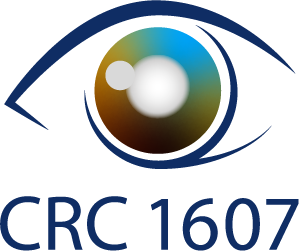„Towards immunomodulatory and anti(lymph)angiogenic therapies for age-related blinding eye diseases”
We are constantly updating the contents of this page. Please visit us again soon.
Research
Program SFB 1607
Healthy eyes are a prerequisite for good vision. Ophthalmology is the medical discipline responsible for preserving and restoring eye function, which is generally done very successfully. There are, however, eye diseases with poorly understood causes and insufficient therapies. As most of these under-addressable eye diseases are age-associated, the prevalence will increase due to our aging society. Beyond significant loss in quality of life of individuals, leaving these diseases under-investigated will affect and burden society, increasing the need for a specialized research center.
Sonderforschungsbereiche (SFB)/Collaborative Research Centers (CRC) in Germany are large and long-term research institutions at universities that run for up to twelve years in which scientists work together as part of an interdisciplinary research program. Collaborative Research Centers are funded exclusively by the German Research Foundation (DFG) from federal and state funds. In contrast to other research funding instruments, CRCs are aimed at a long-term research perspective. CRCs have existed since 1968.
CRC 1607/SFB 1607 on age-related blinding eye diseases is only the second ophthalmological CRC in the history of DFG (the first one being SFB 539 on Glaucoma in Erlangen 1997-2009). The „EYE-CRC“ in Cologne consists of 16 individual projects usually led by two project leaders and 5 additional core units.
Visionary Ocular Innovation
Our CRC has a unique position since there is currently no other international center that focusses on the role of lymphatic/blood vessels and immune cells as the cause of, and new therapeutic target in, age-associated ocular diseases. We therefore propose a new CRC 1607 gathered around the perspective that within 12 years a significant progress in disease understanding and translation into clinical care can be achieved with the following objectives:
- Unravel the disease mechanisms of age-associated eye diseases with a special focus on the role of aberrant cellular immunity/inflammation and (lymph)angiogenesis,
- To develop innovative new treatment concepts based thereon and,
- To transfer at least 25% of projects to early pilot patient data in the last funding period.
Integrative Vision Research Expansion
Tremendous progress has been made in (lymph)angiogenesis and cellular immunity/inflammation research recently. Not least through our research group FOR 2240. Now is the time to transfer this to specific ocular diseases. We included non-ophthalmic experts in the fields of (lymph)angiogenesis and inflammation research as well as image analysis and artificial intelligence into our CRC, thereby enabling (i) a transfer of external expertise to ophthalmological diseases and (ii) better use of the eye as an easily accessible model system to unravel disease mechanisms relevant even beyond ophthalmology.
This will help us to reach our overarching goal: the development of new therapeutic concepts in this area of high unmet need to alleviate the individual and societal burden of age-associated vision loss.



